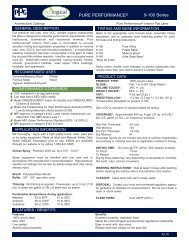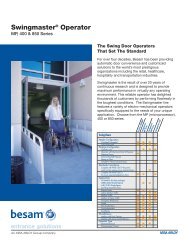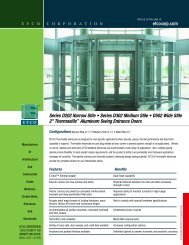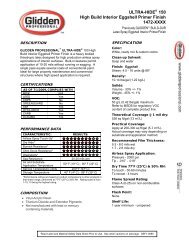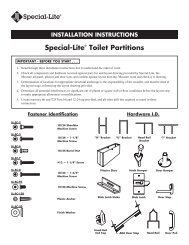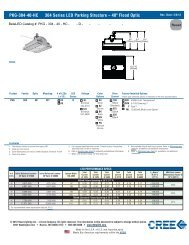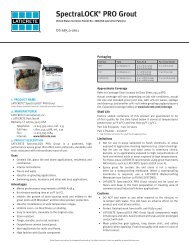Digital Design - McGraw Hill Construction
Digital Design - McGraw Hill Construction
Digital Design - McGraw Hill Construction
Create successful ePaper yourself
Turn your PDF publications into a flip-book with our unique Google optimized e-Paper software.
Photo credit courtesy of Ron St. Angelo<br />
Special advertiSing Section<br />
<strong>Digital</strong> <strong>Design</strong><br />
<strong>Digital</strong> <strong>Design</strong> & construction<br />
&<br />
construction<br />
Interoperability in Action<br />
rom pipelines to powerplants, educational institutions to health facilities, performing arts theaters to sports<br />
stadiums, owners and building professionals have looked to technology for change. More than just a way to<br />
autonomously analyze data, today’s advanced solutions must share information, facilitate business processes<br />
and enable communications. They must, in essence, interoperate.<br />
In 2004, the U.S. National Institute of Standards and Technology estimated that the cost of non-interoperable technology<br />
solutions was almost $16 billion annually. The companies and projects highlighted in the following special section<br />
represent a few of the pioneers who have sought to reduce the staggering cost of disconnection by finding systems<br />
that work together.<br />
These companies and many others have found ways to leverage interoperable tools that seamlessly push and pull data<br />
to ultimately create the framework for more creative, innovative and efficiently-built solutions that will define the next<br />
era of building and infrastructure.<br />
By Vicki Speed<br />
February 2, 2009 www.enr.construction.com/resources/special/ d 1
<strong>Digital</strong> <strong>Design</strong> & construction<br />
When a firm grows from a predominantly Texas-based<br />
regional company to operations in six additional states<br />
and over $1 billion in annual revenue in just 10 years, some<br />
might expect to see signs of growing pains.<br />
Yet, for Austin Commercial, an industry-leading<br />
commercial building general contractor, this steady growth<br />
has sparked powerful and positive change. In this time, the<br />
firm has reshaped its conventional business processes and<br />
incorporated today’s most advanced technology solutions to<br />
meet the needs of its increasingly complex, geographically<br />
diverse organization.<br />
Fred Cardenas, project management systems and technical<br />
support at Austin Commercial, says, “Along with the challenges of<br />
geographic diversity, technology advancements in general have<br />
changed expectations. Gone are the days where a cell phone and<br />
fax machine are sufficient. Our typical jobsites have multiple T1<br />
lines, voice over IP telephones, high-definition video conferencing<br />
and large format printers. Owners, architects and our own<br />
employee owners have come to expect the availability of these<br />
tools in order to facilitate communication.”<br />
While continuing its business growth to new regions, Austin<br />
Commercial has focused on creating a technology-driven business<br />
process that reduces redundant data entry and consolidates data<br />
and reports into one centralized data store.<br />
Cardenas says, “The idea is to link silos of data and<br />
exchange it with various organizations, users, systems and<br />
platforms, in essence to deliver interoperability. Although<br />
interoperability sounds easy, it’s not. In order to be successful<br />
you need to establish the fundamentals and develop a set of<br />
clearly defined goals. We started with two key components<br />
Special advertiSing Section<br />
texas-Based contractor reaps rewards<br />
of interoperable expectations<br />
of the project life cycle—project and document<br />
management.”<br />
To this end, Austin Commercial implemented<br />
the Prolog ® project management control solution from<br />
Meridian Systems to drive collaboration, purchasing<br />
management, cost control, document management<br />
and field administration. Next, Cardenas and his<br />
team implemented the Project Document Manager<br />
(PDM) document control solution from <strong>McGraw</strong>-<strong>Hill</strong><br />
<strong>Construction</strong> (MHC), an interoperable document<br />
management tool designed to store, post, print and<br />
manage documents from pre-design through closeout<br />
directly from the MHC Network.<br />
“Beyond functionality, the value of PDM is its<br />
integration with tools such as Prolog which allow us to<br />
synchronize all project data from design documents<br />
to project schedules and costs,” explains Cardenas.<br />
“The possibilities are endless but the main integration points are<br />
document control, project management, schedule, accounting<br />
and, most recently, building model objects.”<br />
PDM offers full integration with Prolog, as well as with<br />
AutoCAD ® for design review, an E-plan room for construction<br />
and a comprehensive cradle to grave archive process for<br />
closeout and facilities management. It also provides access<br />
to Thomas Reprographics and the MHC/ReproMAX national<br />
network of plan room and reprographic centers and integrates<br />
with MHC’s Network, Dodge and Sweets. Additionally, PDM<br />
users can search the MHC Network - Global Directory for subs<br />
and vendors and then synchronize that information with Prolog<br />
or other tools.<br />
Perhaps, the most satisfied user of the PDM/Prolog tools<br />
is Warren Ames, corporate project controls manager. He says,<br />
“Close-out documentation, typically one of the most painstaking<br />
and tedious aspects of any project, is light years better than just<br />
a few years ago. I have all design, schedule and cost information<br />
at my fingertips along with the ability to process the necessary<br />
documents into one cohesive unit. Preparing close-outs has<br />
become, dare I say, almost enjoyable.”<br />
Cardenas concludes, “The industry has talked about<br />
interoperability for years and many don’t realize that it’s actually<br />
possible, particularly in the area of project management. While<br />
we’ve still got some work to do to bring design, estimating<br />
and scheduling systems together in a similar interoperable<br />
environment, we believe building information modeling is the<br />
spark necessary to take this next step.” s<br />
D 2 www.enr.construction.com/resources/special/ February 2, 2009<br />
Photo image provided by Ron Perkins, Adenium Systems
Photo courtesy of PC Haines Drywall & Ceiling Contractors.<br />
Special advertiSing Section<br />
<strong>Digital</strong> <strong>Design</strong> & construction<br />
specialty contractor edges out competition with Production control<br />
f you cannot measure productivity,<br />
“Iyou will probably not be successful at<br />
managing it,” says Scott Kimpland, director of<br />
Project Execution for FMI Corporation.<br />
The inability to easily and accurately<br />
monitor actual production rates versus<br />
estimated rates can cause inefficiency, or<br />
worse, put a contractor out of business.<br />
“For many labor-intensive contractors, a<br />
10% change in productivity can have a 50%<br />
or greater impact on the bottom line,” adds<br />
Kimpland. “With this in mind, the best and most<br />
profitable contractors have great systems and<br />
processes in place to monitor the ‘score’ from<br />
the first day of the project to the last.”<br />
PC Haines Drywall & Ceiling Contractors,<br />
a Salunga, PA-based specialty contractor, is one<br />
of these companies. With about $5 million in<br />
revenue annually, the firm accurately measures<br />
labor production on any given project—in<br />
near real-time—using a cost control solution<br />
integrated with estimating and bid information.<br />
Eliminating thE guEsswork<br />
PC Haines specializes in the installation of drywall, acoustic tile,<br />
plaster, steel studs and exterior insulation finishing systems<br />
(EFIS) on commercial projects throughout Pennsylvania,<br />
Maryland, Delaware and New Jersey.<br />
Several years ago, the firm implemented <strong>Digital</strong> Production<br />
Control TM from On Center Software, a labor production<br />
management tool. The tool is integrated with the estimated<br />
budget from On Center’s Quick Bid and the graphical takeoff<br />
within On Center’s On-Screen Takeoff ® .<br />
Foremen in the field enter production information into the<br />
<strong>Digital</strong> Production Control solution where it is combined with<br />
project estimates and budgets. The data is compiled into visual<br />
and easily accessible reports that reflect labor production<br />
tasks, labor hours and completion percentages.<br />
Paul Haines, owner of PC Haines, says, “Everyone from<br />
foremen to project managers have instant production<br />
information. It gives you the ability to see where your overruns<br />
will be, and try to do something about them. We always know<br />
the status of our job.”<br />
instant accEss for all<br />
PC Haines’ foremen rely on the system to line out work crews<br />
at the beginning of the workday based on the estimated budget<br />
for the labor tasks to be completed. At the end of the day, the<br />
PC Haines project site, Area 6, Fort Indiantown Gap, PA, steel stud installation.<br />
foremen can review real-time data regarding the work that has<br />
been completed.<br />
Haines adds, “We know immediately if there is a<br />
production problem at any point of a project since hours are<br />
directly correlated to how much material is in a job. If our hours<br />
are working out, then we know materials are pretty close. If we<br />
see a potential cost overrun problem, it shows up in red, giving<br />
us time to react.”<br />
The day-to-day visibility of a project’s progress can<br />
distinguish one contractor from another.<br />
FMI’s Kimpland says, “Many companies do not realize<br />
that a project is in trouble until it’s 90% complete. At that<br />
point, it’s too late to do anything about it. The key is to identify<br />
productivity problems early in the project when corrective<br />
actions can be taken. A tool like <strong>Digital</strong> Production Control<br />
takes all of the guesswork out of how a project is performing<br />
and provides a great way to set daily goals with the crew based<br />
on the estimate.”<br />
Haines agrees, concluding, “What often separates me from<br />
my competitors is the low cost of overhead to manage projects<br />
effectively. [Most companies the size of PC Haines] must have<br />
twice as many people managing projects costs. We do it with<br />
two or three. <strong>Digital</strong> cost control has dramatically changed our<br />
bottom line. We are more efficient while providing our clients<br />
with consistently accurate bids and quality products.” s<br />
February 2, 2009 www.enr.construction.com/resources/special/ D 5
Special advertiSing Section<br />
<strong>Digital</strong> <strong>Design</strong> & construction<br />
the importance of “Deliverability” in Your Project communication<br />
Effective and successful project management relies on<br />
timely and effective communication. Anyone managing<br />
a project must be able to respond quickly to inquiries and<br />
requests for information from project participants.<br />
Email and fax technology has made it easy to send more<br />
messages faster than ever before. Unfortunately these same<br />
delivery channels have become clogged with spam and junk<br />
messages that, ironically, have made it more difficult for you to<br />
get the attention of and response from your recipients.<br />
Measuring whether or not your messages are received<br />
is called “deliverability.” Companies that don’t address this<br />
growing concern can expect certain consequences:<br />
Skipped, missed or miscommunication with contractors<br />
and suppliers can directly result in lost projects and<br />
lost profits<br />
Legal action and fines can occur when messages are<br />
viewed as spam<br />
Annoyed recipients have the ability to ban all future<br />
communications (blocks and spam reports)<br />
Your company can actually get “blacklisted” by major<br />
delivery systems and internet service providers (ISPs),<br />
affecting all future communication<br />
Because marketers have used this medium to deliver unsolicited<br />
messages, corporate IT departments and ISPs developed spam<br />
filters and auto junk filing to filter messages being delivered to<br />
recipients.<br />
The more companies try to bypass these filters, the<br />
stricter the filters get and the worse the deliverability challenge<br />
becomes for everyone. The major email ISPs review and<br />
calculate the reputation of the sender. Reputation is determined<br />
by the number of messages sent, the number of bad addresses<br />
and the number of recipients reporting your message as spam<br />
as well as other factors. Your reputation determines if your<br />
mail gets delivered to the junk folder, or at all. Sending 100 to<br />
1,000 emails as a project blast has not just become ineffective,<br />
but can actually be detrimental to your reputation and future<br />
communication efforts.<br />
Before you continue your project communication efforts,<br />
examine your current process to ensure that you are being as<br />
effective as you can be.<br />
Some questions to ask:<br />
Is someone monitoring the number of messages sent or<br />
your response?<br />
Are you getting the desired response from your<br />
existing system?<br />
Are you analyzing the cost and effect of unsent<br />
messages (bad email/fax), “bounce backs” and<br />
undeliverable messages, unread messages<br />
(placed in junk/spam folder)<br />
The Blue Book’s BB-Bid system can help. This free project<br />
communication network can improve your deliverability and<br />
the effectiveness of all of your project communication.<br />
The Blue Book employs industry best practices and<br />
utilizes delivery methods that take into account deliverability<br />
measurables. The Blue Book has built relationships with the top<br />
FAX and email ISPs so BB-Bid, quickly becoming the industry’s<br />
premier vendor communication system, can help you stay<br />
focused on building relationships not simply messaging.<br />
Interesting Statistics:<br />
B2B subscribers are twice as likely to consider email<br />
spam if it comes too frequently.<br />
The Blue Book realizes the importance of the<br />
effectiveness of your message rather than the quantity.<br />
The BB-Bid messaging platform allows you focus on the<br />
“who” of messaging not the “how.”<br />
31% of B2B email addresses will change this year.<br />
The Blue Book can help you keep your database up to<br />
date and reduce the number of undeliverable messages.<br />
Inbox providers such as Yahoo, AOL and Gmail all use the<br />
percentage of people who hit “report spam” for a<br />
particular sender as the number one gauge in whether<br />
to deliver incoming email or not.<br />
By taking advantage of The Blue Book’s knowledge of<br />
deliverability you can minimize the risk of your messages<br />
being viewed as spam.<br />
Make sure your company is examining deliverability and<br />
consider The Blue Book’s BB-Bid system to help expedite your<br />
project communication as well as protect it.<br />
Please call 888-303-2243 if you have any questions or<br />
would like more information. s<br />
D 8 www.enr.construction.com/resources/special/ February 2, 2009
Photo Credit goes here.<br />
Special advertiSing Section<br />
<strong>Digital</strong> <strong>Design</strong> & construction<br />
Harnessing the sun’s rays<br />
Owners and industry professionals now have a solar-powered “green” security<br />
solution as an alternative to environmentally unfriendly gas generators or to<br />
support limited power source conditions.<br />
The solar mobile surveillance unit (MSU) from CPS Security includes a 360°<br />
rotating solar panel and night vision cameras. This self-contained surveillance<br />
powerhouse can be located virtually anywhere for maximum flexibility. With a<br />
quick and easy setup, the MSU is ready to connect and protect any property or<br />
construction site without any of the typical surveillance system limitations.<br />
The new CPS Solar MSU features an exclusive power-management system<br />
that constantly monitors equipment conditions of and transmits signals back to<br />
the central station. An extended battery backup powers the system for up to<br />
four days in the event of an outage.<br />
Many find that the Solar MSU quickly pays for itself through energy and<br />
equipment cost savings. “Through the use of infrared illumination and without the<br />
need for expensive, polluting generators, the energy cost savings are substantial,<br />
while benefits to the environment are evident,” said Chris Coffey, CEO of CPS<br />
Security. “We are committed to doing our part to become more energy efficient<br />
and to reduce pollution.”<br />
CPS’s signature product, the eCamSecure MSU is known to reduce the<br />
overall cost of construction site security while increasing efficiency. Its mere<br />
presence is a crime deterrent as it maintains wireless visual and audio contact<br />
with a property owner or builder 24 hours a day. For over 22 years, CPS Security<br />
Solutions has been known as an industry leader in surveillance and protection<br />
of construction sites. CPS takes great pride in its research and development of<br />
industry innovations fueled by cutting-edge technology. s<br />
February 2, 2009 www.enr.construction.com/resources/special/ D 9
Special advertiSing Section<br />
<strong>Digital</strong> <strong>Design</strong> & construction<br />
engineering a new approach to Project controls<br />
Whether designing an advanced processing plant or a<br />
turnaround pipeline maintenance contract, engineering an<br />
oil and gas project begins with the schedule, not an estimate.<br />
Engineers from CH2M HILL’s energy and industrial<br />
business unit believe the distinction is significant. In a break<br />
from conventional practice, they have set aside traditional cost<br />
estimating techniques in favor of a schedule-driven project<br />
controls approach built on advanced interoperable technology.<br />
Fumio Otsu, project controls manager with CH2M HILL,<br />
says, “For the first time, we can focus on managing the project,<br />
rather than trying to correlate resource data and estimates to<br />
the project scope.”<br />
The project controls approach begins with engineers<br />
defining activities for a given project using the Primavera P6<br />
scheduling program. These activities are detailed within the<br />
WinEstimator construction estimating solution. When the<br />
estimate is complete, the cost and resource data is pushed<br />
back to the scheduling program where it is aligned with properly<br />
sequenced schedule activities.<br />
A fundamental part of this project controls method is an<br />
interoperable technology framework between the scheduling<br />
and estimating tools.<br />
The push and pull of data between the estimating and scheduling<br />
tool is facilitated by an application programming interface data<br />
transfer built into the WinEst software, which allows the software<br />
to communicate directly with the Primavera scheduling solution.<br />
Otsu explains, “This direct connection brings all schedule<br />
and cost data together when we need it, how we need it. In<br />
minutes, we can create a functionally complete schedule and<br />
cost performance program for any project at any time. Bottom<br />
line, we have complete budgetary control and visibility.”<br />
So far, this technology-driven project controls approach<br />
has helped Otsu’s organization achieve 10% productivity gains<br />
in scheduling and reporting, delivering information consistently<br />
and producing accurate estimates. s<br />
D 10 www.enr.construction.com/resources/special/ February 2, 2009
Special advertiSing Section<br />
<strong>Digital</strong> <strong>Design</strong> & construction<br />
contractor Paves new technology connections<br />
From runways to roadways, Looker and Associates, a leading<br />
general contractor based in Puyallup, WA, builds and<br />
rehabilitates highways and infrastructure for public and private<br />
clients in the Northwest.<br />
Now this expert asphalt manufacturing and construction<br />
company has paved its way into an impressive company-wide<br />
digital transformation that connects its people, processes and<br />
data. The first layer of this foundation began several years ago<br />
with the implementation of<br />
HCSS’s HeavyBid ® Estimating.<br />
Bryce Sturrock, estimator<br />
for Looker, says, “Shifting to advanced<br />
bid management gave<br />
us a first look into technology’s<br />
value. We were instantly able<br />
build new bids from previous jobs, change hours and labor, adjust<br />
fuel and maintenance costs, track payments and much more.”<br />
Yet, Sturrock and his team also realized they needed to<br />
create a similar technology edge across the company, to connect<br />
estimates with actual project data. Last year, they did<br />
just that. Looker purchased laptops equipped with wireless<br />
broadband cards equipped with HCSS HeavyJob ® Field Management<br />
Software for its project foremen. Back in the office,<br />
Sturrock and his staff implemented The Dispatcher Resource<br />
Management Software to track the company’s crews and<br />
equipment replaced traditional magnet and dry-erase boards.<br />
“Every system, from the bid package to the project management<br />
tool to the resource system, works seamlessly to<br />
store, share and analyze project information as needed to support<br />
everyone from executives to foremen,” adds Sturrock.<br />
HeavyBid’s general cost information is pushed to the field<br />
providing foremen a baseline to compare actual labor, equipment<br />
and materials<br />
usage. The Dispatcher<br />
resource management<br />
software tracks the<br />
company’s resources<br />
across all jobs. As a<br />
project moves forward,<br />
foremen enter actual values for labor hours and material<br />
usage into HeavyJob from their laptops in the field, which is<br />
then used to automatically prepare daily progress reports for<br />
superintendents.<br />
Sturrock concludes, “This interoperable workflow has empowered<br />
our company. We are more efficient and knowledgeable<br />
about our business, giving us an unbeatable edge against<br />
our competition.” s<br />
An interoperable technology framework<br />
has empowered our company.<br />
Bryce Sturrock, Looker and Associates.<br />
February 2, 2009 www.enr.construction.com/resources/special/ D 11







